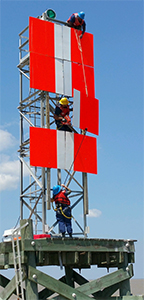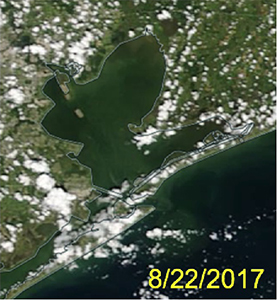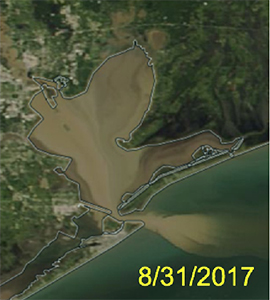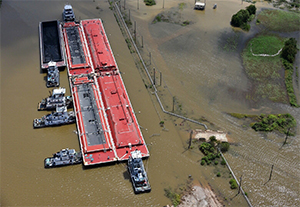Back-to-back hurricanes in the Gulf of Mexico in the late summer damaged vessels, tested contingency plans and caused extended port shutdowns. But authorities say impacts from hurricanes Harvey and Irma will likely be measured in months rather than years.
Although it approached Florida as a Category 5 storm, Hurricane Irma caused limited damage to the state’s 14 public ports when it made landfall in early September, according to Doug Wheeler, president and CEO of the Florida Ports Council.
Texas wasn’t as lucky. Strong winds and unprecedented rainfall from Hurricane Harvey in late August closed key ports in Houston and Corpus Christi for days, delaying shipments of oil, chemicals and other products worth tens of millions of dollars. Shipping channels required dredging in some places, and much of that work was ongoing as of mid-October.
In most cases, shipping resumed within a week after the storm, albeit with draft restrictions, one-way transits and other limitations that also continued into October in some areas, including the busy oil port at Corpus Christi.
 |
|
Coast Guard personnel repair a navigational marker in the lower Houston Ship Channel near Galveston, Texas, after the aid was damaged by Hurricane Harvey. |
|
Courtesy U.S. Coast Guard |
“I don’t think there is a permanent issue,” said Jim Kruse, director of the Center for Ports & Waterways at the Texas A&M Transportation Institute. “Nothing got damaged to the point where it won’t recover. It’s maybe as long as a five- or six-month impact. We have been through several hurricanes and tropical storms, but what made this different was it was so widespread. There was so much water everywhere.”
Hurricane Harvey made landfall north of Corpus Christi on Aug. 25 as a Category 4 storm, causing at least a dozen vessels to break away or run aground near Port Aransas (see Casualties on page 26). The Port of Corpus Christi closed on Aug. 24 and remained that way for a record six days. Many of the region’s refineries also shut down for a time after losing power.
The port’s 47-foot-deep ship channel lost up to 8 feet of depth in some places, and most aids to navigation had to be replaced. The U.S. Coast Guard restricted ship transits to daytime until Sept. 27, and one-way transits remained in effect into October. A port spokesman said vessels were traveling in convoys.
While many port facilities were undamaged, some local maritime operators face a long recovery, including the Aransas-Corpus Christi Pilots. Capt. Jay Rivera, who leads the organization, said the pilot station “suffered catastrophic damage and will need to be replaced.”
The group has operated from a temporary trailer since the storm. Its boats were moored well inland during the storm and were not damaged, Rivera said. Some of the pilots’ homes also were affected by flooding and winds.
Storm-related shoaling was not limited to the Corpus Christi Ship Channel. The Colorado River Locks on the Gulf Intracoastal Waterway, for instance, were closed until late September. Even then, they reopened with an 8-foot draft restriction. Dozens of barge tows were stuck on both sides of the locks awaiting transit, which hindered activity at ports.
“The historic amounts of rain from Hurricane Harvey carried a large amount of sediment down the rivers and bayous and (deposited) it in coastal waters, including harbors, ship channels and the Gulf Intracoastal Waterway,” said Ed Loomis, a spokesman for the U.S. Army Corps of Engineers.
Shoaling also occurred in the Houston Ship Channel. Channel depths in the 50-mile waterway were reduced from 45 feet to 40 feet in some areas, and Loomis said the section from the Houston Cement Plant west to Interstate 610 was reduced to 36 feet in some places. The Port of Houston Authority said shoaling reduced depths by up to 10 feet.
Kruse said the transit restrictions will affect shippers in the near term, who must reduce loads on vessels coming into and leaving Houston.
 |
|
This satellite image from the National Aeronautics and Space Administration was taken Aug. 22, before the storm hit. |
|
Courtesy Port Houston |
“Right now it is more expensive to call on Houston than it normally is. That is a problem, but not a long-term problem,” Kruse said in late September. “It is only until they get the channel dredged, and they are working on that.”
Port officials said Harvey highlighted the need to protect the channel against similar impacts during future storms. The Houston agency said losing a single foot of depth costs the U.S. economy up to $281 million a year.
“We believe that rather than just returning the channel to its pre-storm depth and width, we must enhance its efficiency and we must build in resiliency to make it better for ever-growing demand,” Janiece Longoria, chairman of the Port Commission of the Port of Houston Authority, said in a prepared statement.
As of late September, the Texas ports of Orange and Beaumont were open with restrictions, while Port Arthur was open at its authorized channel depth of 40 feet. The Army Corps will continue to monitor federal channels in the state throughout October and possibly longer.
“Not all of the sediment picked by the runoff from Harvey’s extreme rainfall has reached its final destination, so the district surveys of federal channels will continue in the weeks ahead,” Loomis said.
 |
|
Satellite images from the National Aeronautics and Space Administration show the high volume of sediment washed into the channel due to stormwater runoff from the hurricane. |
|
Courtesy Port Houston |
Across the Gulf of Mexico, conditions at most Florida ports returned to normal far more quickly than in Texas. Although Irma tracked up the state’s Gulf Coast, the Port of Tampa sustained little damage. Within two days of the storm’s passing, the port’s fuel terminals were open and ships were offloading gasoline and other fuels.
Port officials in Jacksonville described little or no physical damage to their facilities. The Port of Key West was among the last ports in the state to reopen, due largely to the number of sunken recreational boats, said Wheeler of the Florida Ports Council.
Irma generated widespread media attention for days before its landfall near Naples, giving residents and port officials time to put hurricane action plans into effect. The storm also moved relatively quickly rather than sitting over the state.
“We were absolutely prepared for it to be much worse,” Wheeler said, “and we were very fortunate that things were not as bad as they could have been.”

